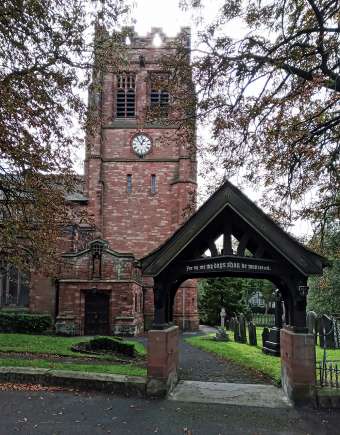Church of St Peter, Church Street, Newton-le-Willows
Built largely at the expense of George McCorquodale and his family on the site of a seventeenth-century chapel. A new chancel was built in 1892-93, but with the death of George McCorquodale two years later, his family decided to rebuild the nave in his memory. This was completed in 1898. In the same year, the vicar, Herbert Monk, died. He had been the prime mover in the effort to rebuild the church. In his will, he left money for the erection of the tower, which was dedicated in 1901. A peal of bells was added. In 1903, the lych-gate was erected to the memory of W. J. Legh, first Baron of Newton.
ST. PETER'S CHURCH, NEWTON-LE-WILLOWS - This church replaces one of 50 years ago. The first section, comprising the chancel, organ chamber, vestry and side chapel, is completed, the nave of the old church being retained for the congregation until funds permit of the remainder of the work being proceeded with. The outside walls are of red Rainhill stone, the inside being faced with a soft creamy-coloured stone obtained from the neighbourhood of Ormskirk, with red bands promiscuously introduced. The main roof is covered with green Westmoreland slates, and the aisles and vestry with lead. The walls of the chancel are panelled round 10 ft. high to match the screens, all of which are of wainscot oak, and above the altar is a richly-carved triptych, which is to be painted by Messrs. Shrigley and Hunt. - Walter H Brierley. [British Architect 25 January 1895 Page 58]
Newton-le-Willows was Walter Brierley’s childhood home. His parents, who were living in the village at the time of the rebuilding are buried in the churchyard close to the lych-gate.
Old Vicarage, 2 Castle Hill replacing a Victorian house on the site of the present car park. This appears to be contemporary with the rebuilding of the church. By Brierley? In 1988 the vicarage was sold and a smaller vicarage built.
Reference British Architect 25 January 1895 Page 58 with illustration
